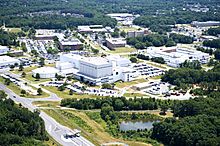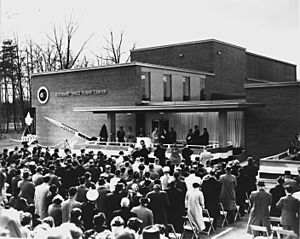History of the Goddard Space Flight Center facts for kids
 |
|
 Aerial view of the Goddard Space Flight Center |
|
| Agency overview | |
|---|---|
| Formed | May 1, 1959 |
| Jurisdiction | Federal government of the United States |
| Headquarters | Greenbelt, MD |
The Goddard Space Flight Center (GSFC) is NASA's first and oldest space center. It is named after Robert H. Goddard, who is known as the father of modern rocketry. Since it started, the center has managed and developed many important space missions. These include the Hubble Space Telescope, the Lunar Reconnaissance Orbiter, and the Solar Dynamics Observatory. GSFC helps us learn more about Earth, the Solar System, and the universe.
Contents
How Goddard Space Flight Center Started
On July 29, 1958, President Eisenhower signed a law that created the National Aeronautics and Space Administration, or NASA. NASA officially began on October 1, 1958. It started with four laboratories and about 80 employees from an older research group called NACA.
The Goddard Space Flight Center was created on May 1, 1959. It was NASA's very first center focused on space flight. Its main jobs were to develop new technology, plan missions, do scientific research, handle technical operations, and manage projects. Even today, the center is organized into different groups, each doing one of these key jobs.
Before it was named Goddard, the center in Greenbelt, Maryland was called the Beltsville Space Center. It was renamed after Robert H. Goddard, the rocket pioneer. Its first 157 employees came from the United States Navy's Project Vanguard rocket program. They kept working at the Naval Research Laboratory while the new center was being built.
Goddard's Amazing History
Early Days: 1959
In January 1959, the Beltsville Space Center was officially set up with four main divisions. These divisions focused on construction, space sciences, theory, and the Vanguard program. People quickly agreed that the center would handle five major space science tasks: project management, research, development and building, advanced planning, and operations.
On May 1, 1959, T. Keith Glennan, the NASA Administrator, announced that the center would be renamed the Goddard Space Flight Center. This was to honor Dr. Robert H. Goddard. In September 1959, Harry J. Goett became the first Director of Goddard Space Flight Center.
Building the new space laboratory began on April 24, 1959. It was built on land that used to be part of a farm research center. By September 1960, the first main building was full, and other buildings were being finished. Even though many people worked in temporary spots, Goddard Space Flight Center was becoming a real place.
Space Race Years: 1960-1969
Goddard Space Flight Center played a big part in Project Mercury. This was America's first program to send humans into space. Goddard was in charge of the project in its early days. It managed the first 250 employees who worked on it.
However, Project Mercury grew very quickly. So, NASA decided to build a new "Manned Spacecraft Center" in Houston, Texas. This center is now called the Johnson Space Center. All the people and activities for Project Mercury moved there in 1961.
During the early human spaceflight missions, like Project Mercury, Project Gemini, and the Apollo program, GSFC was in charge of managing and running the communication networks. In 1961, Goddard engineers were given the job of designing the Mercury Space Flight Network. This was the first network to support human spaceflight. Later, GSFC was responsible for other important tracking networks too.
In April 1962, NASA launched Ariel 1. This was a joint effort between Goddard and the United Kingdom. It was the first international satellite ever launched! Researchers in the U.K. built the science tools for the satellite. Goddard managed building the satellite itself and the whole project.
New Focus: 1970-1979
After the Apollo program ended, Goddard entered a new time. The race to the Moon had brought a lot of support for NASA. But once that goal was met, NASA's role and funding became less clear. Goddard's focus on science missions and many different projects helped protect it from some of the budget cuts. Even with fewer funds, Goddard's work was growing into new areas. This included developing new technology and using satellites with the Space Shuttle.
Innovation and Repair: 1980-1989
Goddard Space Flight Center stayed involved in human spaceflight. It provided computer support and radar tracking for flights. This was done through a worldwide network of ground stations. However, the center mainly focused on designing uncrewed satellites and spacecraft for science missions.
Goddard pioneered new ways to build spacecraft. One important idea was modular design. This meant building spacecraft in parts, like LEGOs. This made them cheaper and easier to repair in space. Goddard's Solar Maximum Mission satellite, launched in 1980, was repaired by astronauts on the Space Shuttle Challenger in 1984. This was a huge achievement!
Hubble and Beyond: 1990-1999
The Hubble Space Telescope was launched in 1990. It is still working today and has become even better over time. This is thanks to its modular design and several repair missions by the Space Shuttle. Early in this decade, Goddard also managed the launch of the Compton Gamma Ray Observatory. This observatory saw 2,700 gamma-ray bursts. It showed that most of these powerful bursts come from very distant galaxies.
Goddard's work in the early 1990s helped NASA recover after the Space Shuttle Challenger accident. It created new excitement and curiosity about both Earth and other parts of the universe. We now had the technology to look back to the very beginning of time and the farthest reaches of the universe.
Today's Discoveries: 2000-Present
Today, Goddard continues to be involved in all of NASA's main programs. Goddard has developed more tools for planetary exploration than any other group. These science tools have been sent to every planet in our Solar System.
The center also helps us understand Earth. It has built several spacecraft for the Earth Observing System. It also created EOSDIS, a system that collects, processes, and shares Earth science data. For human spaceflight, Goddard develops tools for astronauts to use during spacewalks. It also built and operates the Lunar Reconnaissance Orbiter and the Solar Dynamics Observatory.
Important People at Goddard
Many amazing scientists and engineers have worked at GSFC. Here are a few:
- Carrie Anderson - A planetary scientist known for her work on Titan.
- Beth A. Brown - An astrophysicist.
- Fred Espenak - An astrophysicist famous for predicting eclipses.
- Orlando Figueroa - A former Director of Engineering at Goddard. He also led Mars exploration for NASA.
- James E. Hansen - The head of the NASA Goddard Institute for Space Studies. He is known for his research and warnings about climate change.
- John C. Mather - An astrophysicist and Nobel Prize winner for his work on the Cosmic Background Explorer.
- Judith Racusin - An astrophysicist and research aerospace technologist.
- Aki Roberge - An astrophysicist working on the LUVOIR mission.
- Gerald Soffen - A scientist who helped establish NASA's Astrobiology Institute and many educational programs.
Leaders of Goddard Space Flight Center
Here is a list of the directors who have led the Goddard Space Flight Center:
| # | Director | Start Date | End Date | Time as Director | Started with NASA | Key Achievements |
|---|---|---|---|---|---|---|
| 14 | Makenzie Lystrup | April 6, 2023 | Present | Present | April, 2023 | |
| David Mitchell (Acting) | January 1, 2023 | April 5, 2023 | ~4 months | 1987 | ||
| 13 | Dennis Andrucyk | January 1, 2020 | December 31, 2022 | 2 years | 1988 | |
| George W. Morrow (Acting) | August 1, 2019 | December 31, 2019 | ~5 months | |||
| 12 | Christopher J. Scolese | March 5, 2012 | July 31, 2019 | 7 years | 1987 | Former NASA associate administrator and NASA's chief engineer. |
| 11 | Robert Strain | August 4, 2008 | March 4, 2012 | 4 years | 2008 | Became President of Ball Aerospace & Technologies. |
| Arthur F. "Rick" Obenschain (Acting) | May 7, 2008 | August 3, 2008 | ~3 months | |||
| 10 | Edward J. Weiler | August 2, 2004 | May 6, 2008 | 4 years | 1978 | Former Associate Administrator for NASA's Space Science. |
| 9 | Alphonso (Al) V. Diaz | January 12, 1998 | August 2, 2004 | 6 years | 1964 | |
| 8 | Joseph H. Rothenberg | October 4, 1995 | January 12, 1998 | 3 years | 1983 | Former Associate Administrator for Human Space Flight. |
| Joseph H. Rothenberg (Acting) | April 30, 1995 | October 4, 1995 | ||||
| 7 | John M. Klineberg | July 1, 1990 | April 29, 1995 | 5 years | 25 years total | Former Center Director, NASA Glenn Research Center. |
| 6 | John W. Townsend, Jr. | June 22, 1987 | June 30, 1990 | 3 years | 1958 | |
| 5 | Noel Hinners | June 14, 1982 | June 22, 1987 | 5 years | 1972 | Former Director, Smithsonian National Air and Space Museum. |
| 4 | A. Thomas Young | February 1, 1980 | March 22, 1982 | 3 years | 12 years total | Later a Vice President at Lockheed Martin. |
| Robert (Ed) Smylie (acting director) | June 2, 1979 | January 31, 1980 | ||||
| 3 | Robert S. Cooper | July 1, 1976 | June 1, 1979 | 3 years | 1975 | Later Assistant Secretary of Defense. |
| 2 | John F. Clark | May 5, 1965 | July 1, 1976 | 11 years | 1965 | |
| 1 | Harry J. Goett | September 1, 1959 | July 1965 | 6 years | 1959 |


